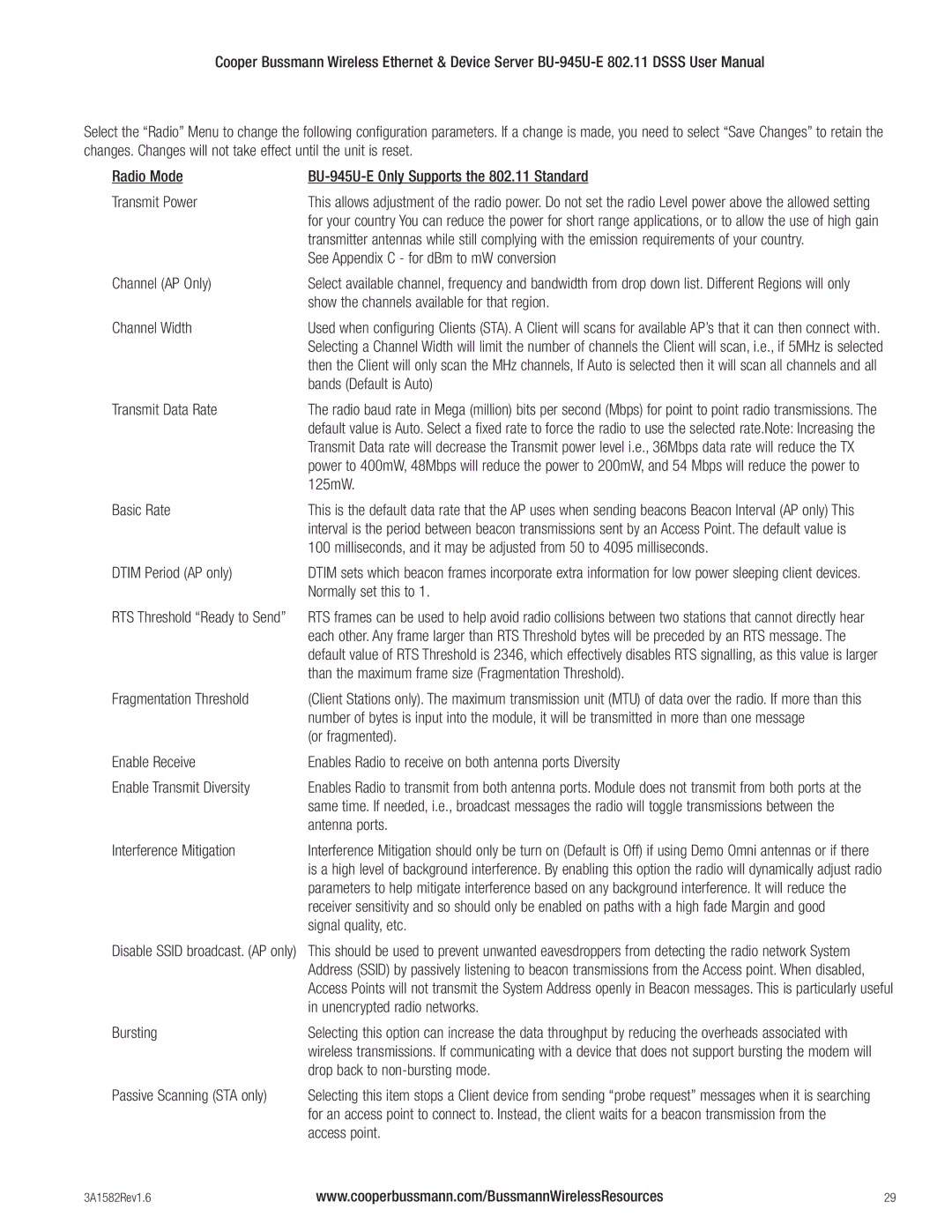Cooper Bussmann Wireless Ethernet & Device Server
Select the “Radio” Menu to change the following configuration parameters. If a change is made, you need to select “Save Changes” to retain the changes. Changes will not take effect until the unit is reset.
Radio Mode | |
Transmit Power | This allows adjustment of the radio power. Do not set the radio Level power above the allowed setting |
| for your country You can reduce the power for short range applications, or to allow the use of high gain |
| transmitter antennas while still complying with the emission requirements of your country. |
| See Appendix C - for dBm to mW conversion |
Channel (AP Only) | Select available channel, frequency and bandwidth from drop down list. Different Regions will only |
| show the channels available for that region. |
Channel Width | Used when configuring Clients (STA). A Client will scans for available AP’s that it can then connect with. |
| Selecting a Channel Width will limit the number of channels the Client will scan, i.e., if 5MHz is selected |
| then the Client will only scan the MHz channels, If Auto is selected then it will scan all channels and all |
| bands (Default is Auto) |
Transmit Data Rate | The radio baud rate in Mega (million) bits per second (Mbps) for point to point radio transmissions. The |
| default value is Auto. Select a fixed rate to force the radio to use the selected rate.Note: Increasing the |
| Transmit Data rate will decrease the Transmit power level i.e., 36Mbps data rate will reduce the TX |
| power to 400mW, 48Mbps will reduce the power to 200mW, and 54 Mbps will reduce the power to |
| 125mW. |
Basic Rate | This is the default data rate that the AP uses when sending beacons Beacon Interval (AP only) This |
| interval is the period between beacon transmissions sent by an Access Point. The default value is |
| 100 milliseconds, and it may be adjusted from 50 to 4095 milliseconds. |
DTIM Period (AP only) | DTIM sets which beacon frames incorporate extra information for low power sleeping client devices. |
| Normally set this to 1. |
RTS Threshold “Ready to Send” | RTS frames can be used to help avoid radio collisions between two stations that cannot directly hear |
| each other. Any frame larger than RTS Threshold bytes will be preceded by an RTS message. The |
| default value of RTS Threshold is 2346, which effectively disables RTS signalling, as this value is larger |
| than the maximum frame size (Fragmentation Threshold). |
Fragmentation Threshold | (Client Stations only). The maximum transmission unit (MTU) of data over the radio. If more than this |
| number of bytes is input into the module, it will be transmitted in more than one message |
| (or fragmented). |
Enable Receive | Enables Radio to receive on both antenna ports Diversity |
Enable Transmit Diversity | Enables Radio to transmit from both antenna ports. Module does not transmit from both ports at the |
| same time. If needed, i.e., broadcast messages the radio will toggle transmissions between the |
| antenna ports. |
Interference Mitigation | Interference Mitigation should only be turn on (Default is Off) if using Demo Omni antennas or if there |
| is a high level of background interference. By enabling this option the radio will dynamically adjust radio |
| parameters to help mitigate interference based on any background interference. It will reduce the |
| receiver sensitivity and so should only be enabled on paths with a high fade Margin and good |
| signal quality, etc. |
Disable SSID broadcast. (AP only) | This should be used to prevent unwanted eavesdroppers from detecting the radio network System |
| Address (SSID) by passively listening to beacon transmissions from the Access point. When disabled, |
| Access Points will not transmit the System Address openly in Beacon messages. This is particularly useful |
| in unencrypted radio networks. |
Bursting | Selecting this option can increase the data throughput by reducing the overheads associated with |
| wireless transmissions. If communicating with a device that does not support bursting the modem will |
| drop back to |
Passive Scanning (STA only) | Selecting this item stops a Client device from sending “probe request” messages when it is searching |
| for an access point to connect to. Instead, the client waits for a beacon transmission from the |
| access point. |
3A1582Rev1.6 | www.cooperbussmann.com/BussmannWirelessResources | 29 |
